Land Use and Land Coverage Analysis with Google Earth Engine and Change Detection in the Sonipat District of the Haryana State in India †
Abstract
1. Introduction
2. Study Area
3. Methodology and Data Used
3.1. Land Use Land Cover Classification
- Image selection.
- Collection of training samples.
- Running the classifier.
3.2. Accuracy Assessment
3.3. Change Detection and Prediction
4. Results and Discussions
4.1. LULC Classification
4.2. Accuracy Assessment
4.3. Change Detection
4.4. Prediction
5. Conclusions
Author Contributions
Funding
Institutional Review Board Statement
Informed Consent Statement
Data Availability Statement
Conflicts of Interest
References
- Lekha, S.L.S.; Kumar, S.S. Classification and Mapping of Land Use Land Cover Change in Kanyakumari District with Remote Sensing and GIS Techniques. Int. J. Appl. Eng. Res. 2018, 13, 158–166. Available online: http://www.ripublication.com (accessed on 10 September 2022).
- Kamaraj, M.; Rangarajan, S. Predicting the future land use and land cover changes for Bhavani basin, Tamil Nadu, India, using QGIS MOLUSCE plugin. Environ. Sci. Pollut. Res. 2022, 29, 86337–86348. [Google Scholar] [CrossRef] [PubMed]
- Twisa, S.; Buchroithner, M.F. Land-Use and Land-Cover (LULC) Change Detection in Wami River Basin, Tanzania. Land 2019, 8, 136. [Google Scholar] [CrossRef]
- Chamling, M.; Bera, B. Spatio-temporal Patterns of Land Use/Land Cover Change in the Bhutan–Bengal Foothill Region Between 1987 and 2019: Study Towards Geospatial Applications and Policy Making. Earth Syst. Environ. 2020, 4, 117–130. [Google Scholar] [CrossRef]
- Nedd, R.; Light, K.; Owens, M.; James, N.; Johnson, E.; Anandhi, A. A Synthesis of Land Use/Land Cover Studies: Definitions, Classification Systems, Meta-Studies, Challenges and Knowledge Gaps on a Global Landscape. Land 2021, 10, 994. [Google Scholar] [CrossRef]
- García-Álvarez, D.; Olmedo, M.T.C.; Mas, J.-F.; Paegelow, M. Land Use Cover Mapping, Modelling and Validation. A Background. In Land Use Cover Datasets and Validation Tools; Springer International Publishing: Cham, Swizerland, 2022; pp. 21–33. [Google Scholar] [CrossRef]
- Gondwe, J.F.; Lin, S.; Munthali, R.M. Analysis of Land Use and Land Cover Changes in Urban Areas Using Remote Sensing: Case of Blantyre City. Discrete Dyn. Nat. Soc. 2021, 2021, 8011565. [Google Scholar] [CrossRef]
- Taloor, A.K.; Kumar, V.; Kumar Singh, V.; Kumar Singh, A. Land Use Land Cover Dynamics Using Remote Sensing and GIS Techniques in Western Doon Valley, Uttarakhand, India; Springer: Singapore, 2020; pp. 37–51. [Google Scholar] [CrossRef]
- Megahed, Y.; Cabral, P.; Silva, J.; Caetano, M. Land Cover Mapping Analysis and Urban Growth Modelling Using Remote Sensing Techniques in Greater Cairo Region—Egypt. ISPRS Int. J. Geoinf. 2015, 4, 1750–1769. [Google Scholar] [CrossRef]
- Mohajane, M.; Essahlaoui, A.; Oudija, F.; Hafyani, M.E.; Hmaidi, A.E.; Ouali, A.E.; Randazzo, G.; Teodoro, A.C. Land Use/Land Cover (LULC) Using Landsat Data Series (MSS, TM, ETM+ and OLI) in Azrou Forest, in the Central Middle Atlas of Morocco. Environments 2018, 5, 131. [Google Scholar] [CrossRef]
- Singh, A.I.; Singh, K. Remote Sensing and GIS based Land Use Land Cover Analysis in Chandel District, Manipur, India. IOP Conf. Ser. Earth Environ. Sci. 2021, 889, 012046. [Google Scholar] [CrossRef]
- Alshari, E.A.; Gawali, B.W. Development of classification system for LULC using remote sensing and GIS. Glob. Transit. Proc. 2021, 2, 8–17. [Google Scholar] [CrossRef]
- Tassi, A.; Vizzari, M. Object-Oriented LULC Classification in Google Earth Engine Combining SNIC, GLCM, and Machine Learning Algorithms. Remote Sens. 2020, 12, 3776. [Google Scholar] [CrossRef]
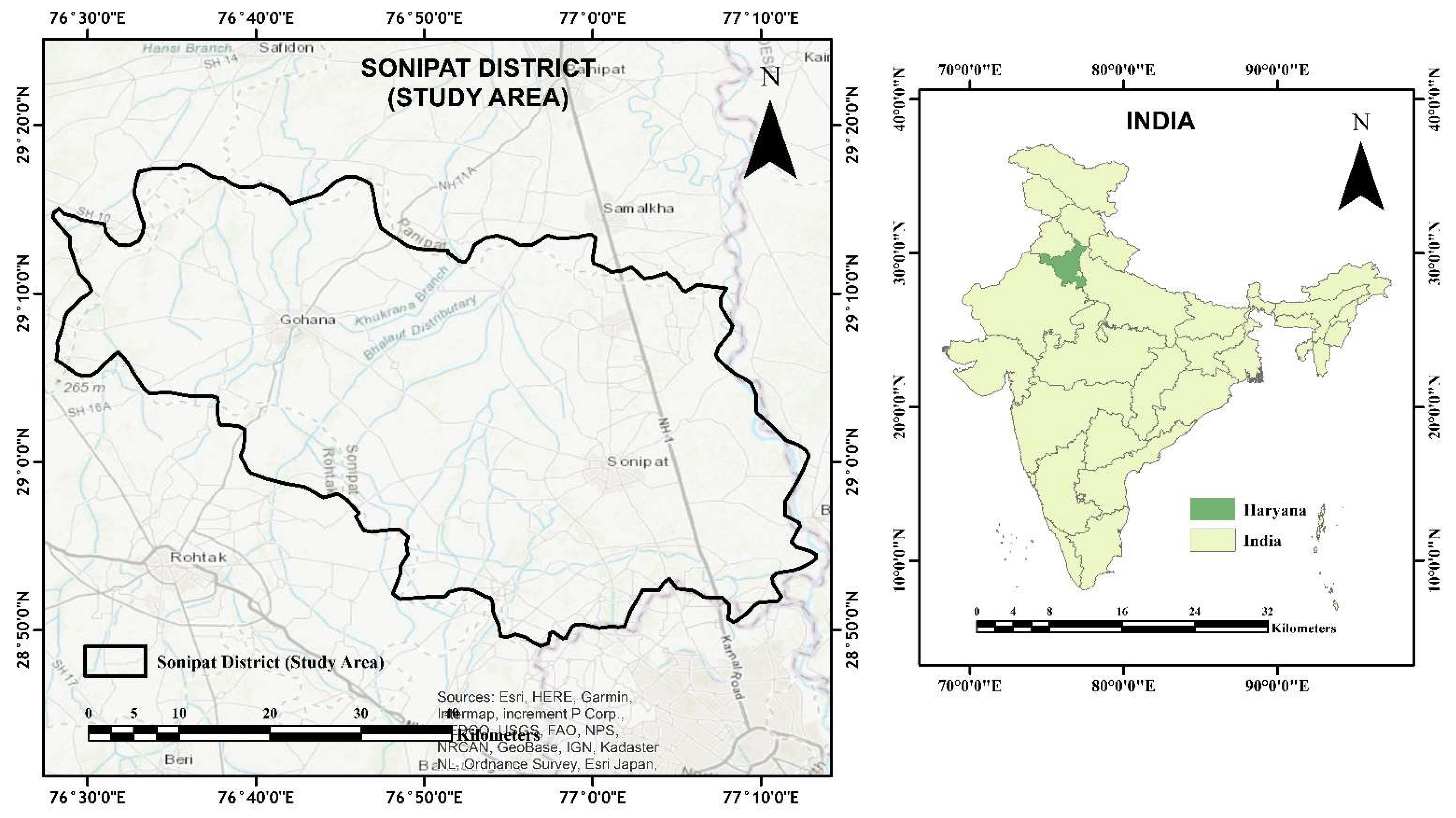
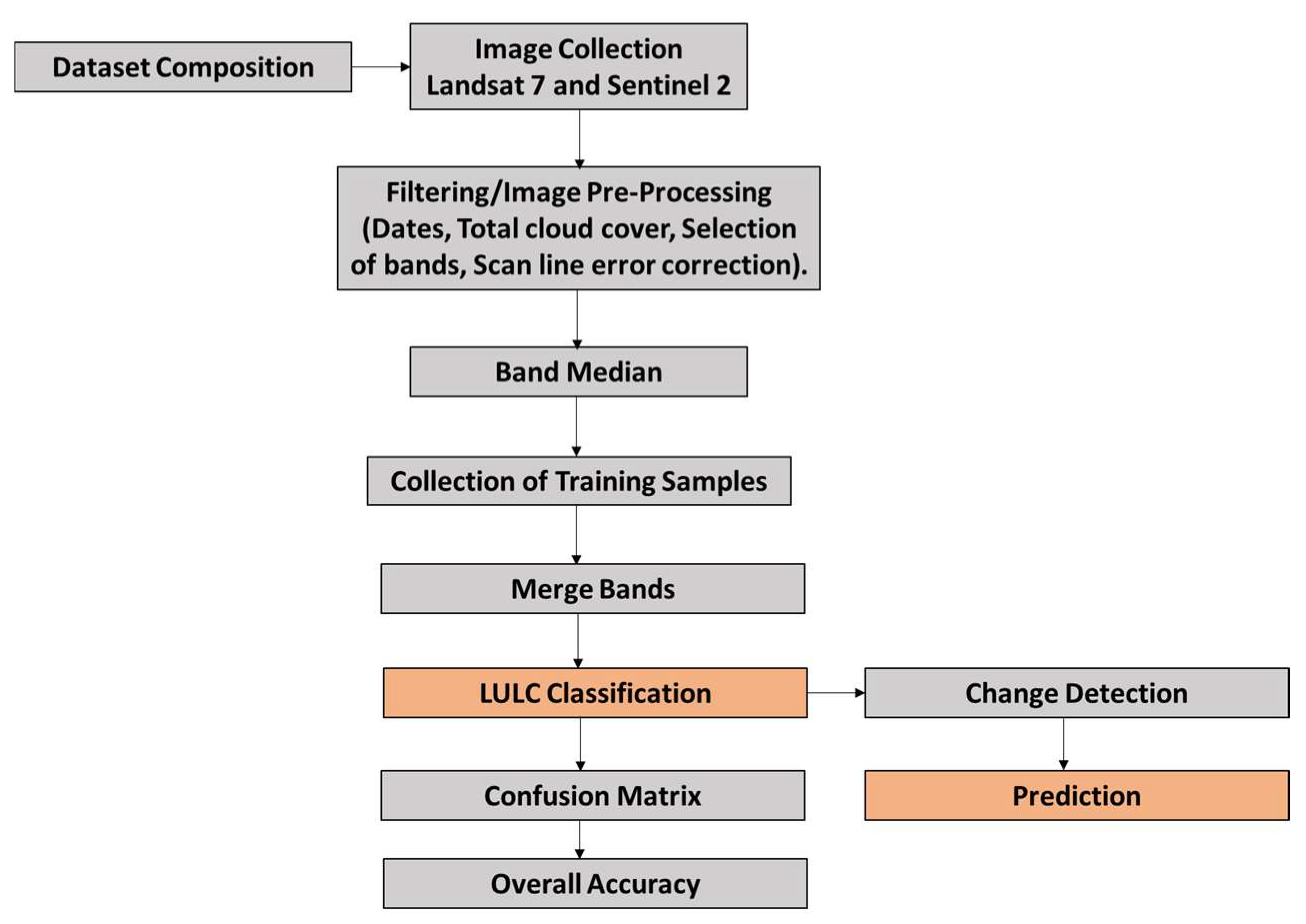
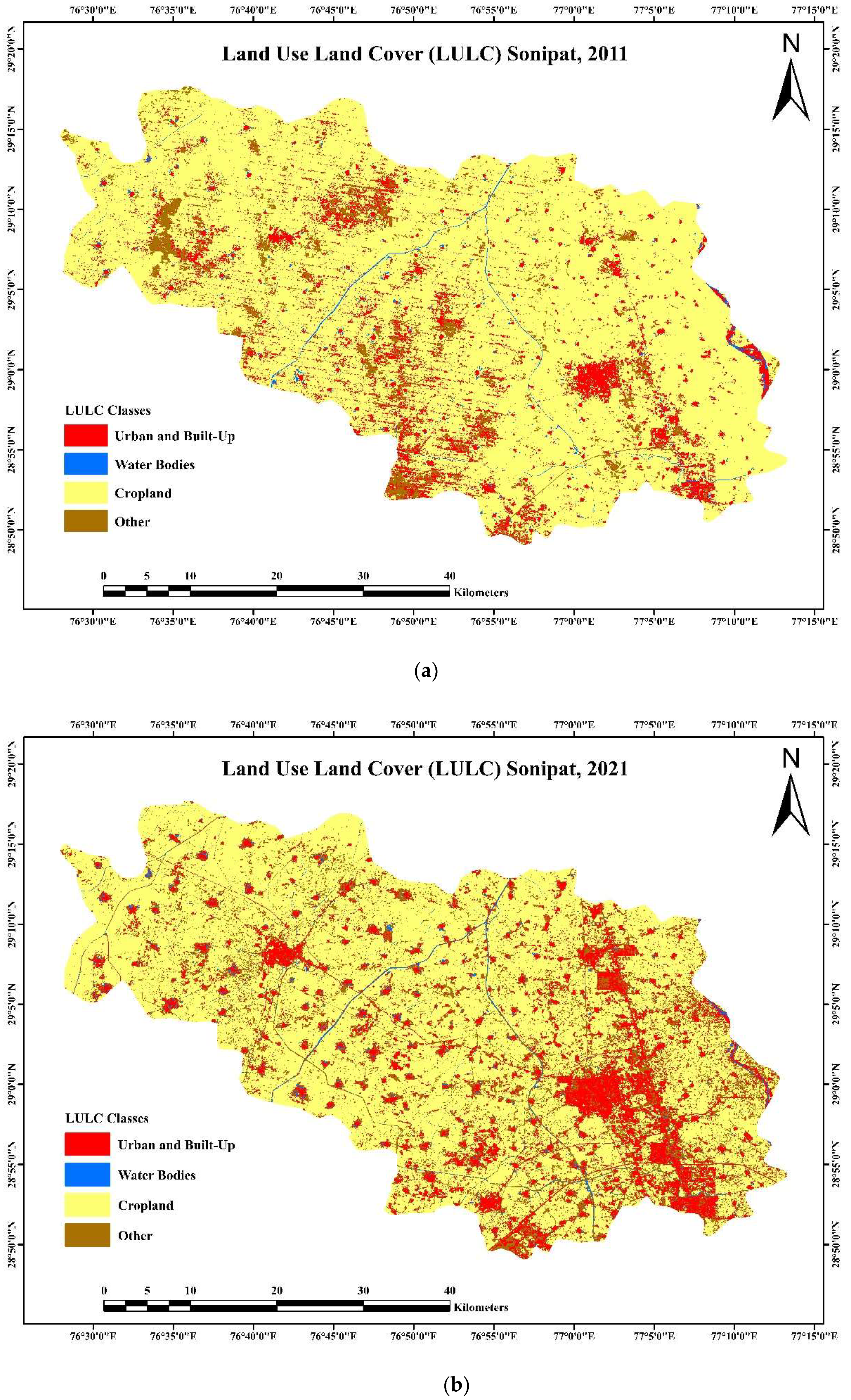
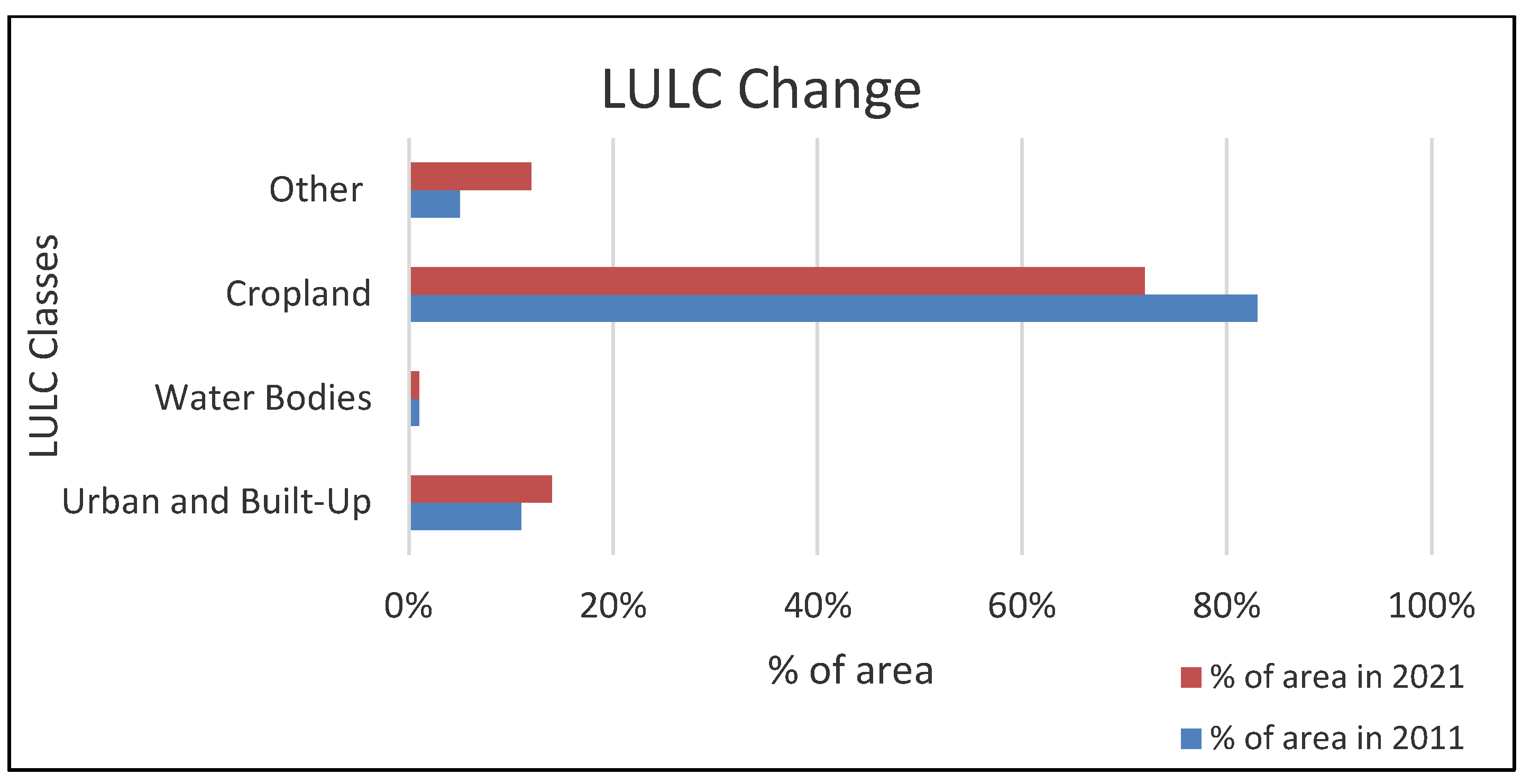
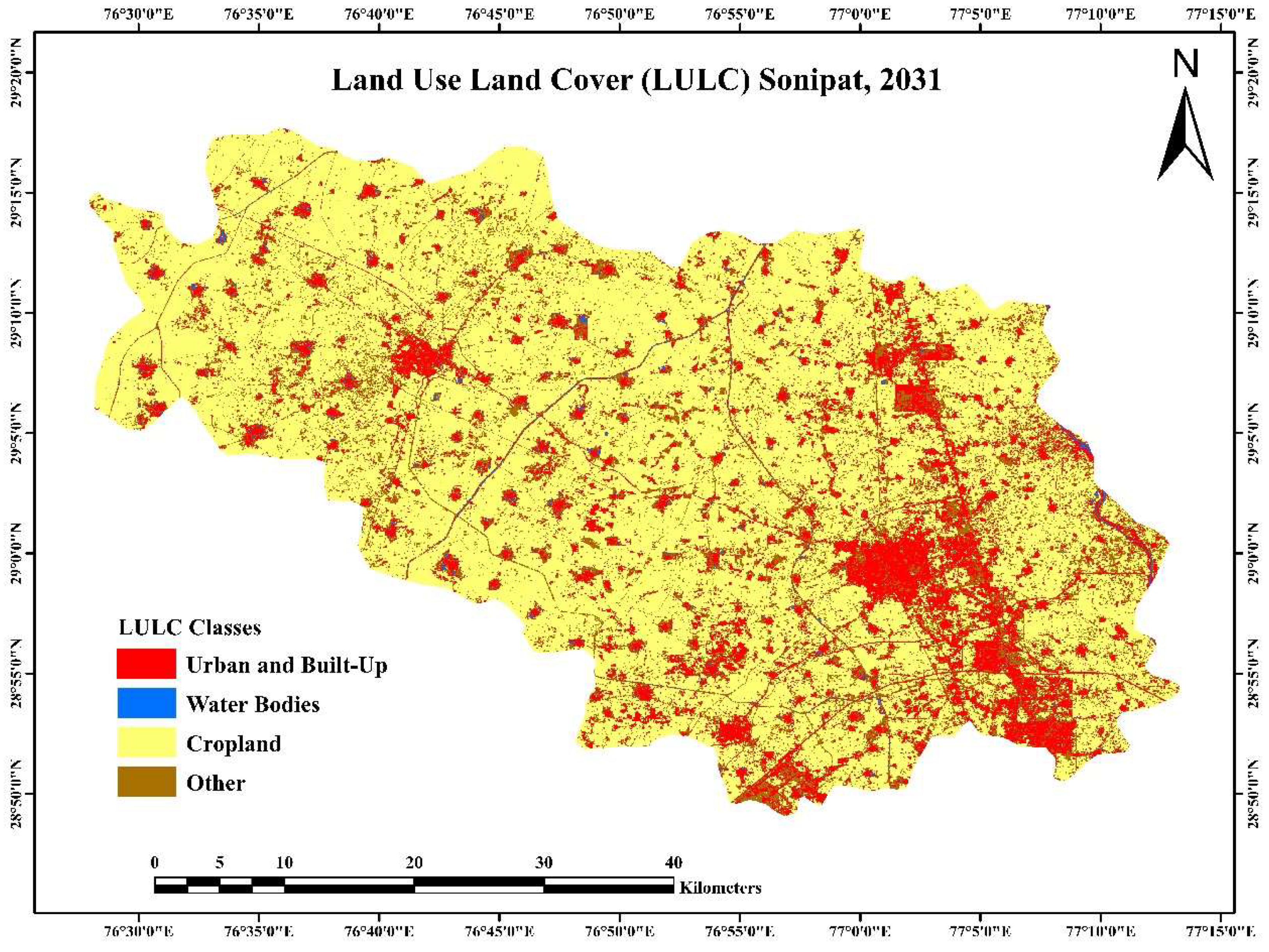
| Validation Error Matrix 2011 | ||||
|---|---|---|---|---|
| LULC Classes | 4 Elements | |||
| Urban and built-up | 16 | 0 | 0 | 0 |
| Water bodies | 0 | 15 | 0 | 0 |
| Cropland | 0 | 0 | 14 | 0 |
| Other (fallow land and barren land) | 1 | 0 | 0 | 14 |
| Validation overall accuracy | 0.98 | |||
| Validation Error Matrix 2021 | ||||
|---|---|---|---|---|
| LULC Classes | 4 Elements | |||
| Urban and built-up | 30 | 0 | 0 | 1 |
| Water bodies | 0 | 14 | 0 | 0 |
| Cropland | 0 | 0 | 18 | 0 |
| Other (fallow land and barren land) | 0 | 0 | 0 | 22 |
| Validation overall accuracy | 0.98 | |||
| LULC Classes | 2011 Area km2 | 2021 Area km2 | Δ | 2011% | 2021% | Δ % |
|---|---|---|---|---|---|---|
| Urban and built-up | 234.81 | 319.87 | 85.06 | 10.60 | 14.45 | 3 |
| Water bodies | 30.55 | 22.81 | −7.74 | 1.38 | 1.35 | −0.34 |
| Cropland | 1843.61 | 1595.11 | −248.49 | 83.29 | 71.41 | −11 |
| Other (fallow land and barren land) | 112.14 | 267.84 | 155.69 | 5.06 | 12.79 | 7 |
| LULC Classes | 2021 Area km2 | 2031 Area km2 | Δ | 2021% | 2031% | Δ % |
|---|---|---|---|---|---|---|
| Urban and built-up | 319.87 | 431.54 | 111.67 | 14.45 | 19.49 | 5.04 |
| Water bodies | 22.81 | 14.95 | −7.86 | 1.35 | 0.69 | −0.66 |
| Cropland | 1595.11 | 1398.04 | −328.52 | 71.41 | 63.16 | −8.25 |
| Other (fallow land and barren land) | 267.84 | 368.84 | 101 | 12.79 | 16.66 | 3.87 |
Publisher’s Note: MDPI stays neutral with regard to jurisdictional claims in published maps and institutional affiliations. |
© 2022 by the authors. Licensee MDPI, Basel, Switzerland. This article is an open access article distributed under the terms and conditions of the Creative Commons Attribution (CC BY) license (https://creativecommons.org/licenses/by/4.0/).
Share and Cite
Rana, D.; Kumari, M.; Kumari, R. Land Use and Land Coverage Analysis with Google Earth Engine and Change Detection in the Sonipat District of the Haryana State in India. Eng. Proc. 2022, 27, 85. https://doi.org/10.3390/ecsa-9-13366
Rana D, Kumari M, Kumari R. Land Use and Land Coverage Analysis with Google Earth Engine and Change Detection in the Sonipat District of the Haryana State in India. Engineering Proceedings. 2022; 27(1):85. https://doi.org/10.3390/ecsa-9-13366
Chicago/Turabian StyleRana, Diksha, Maya Kumari, and Rina Kumari. 2022. "Land Use and Land Coverage Analysis with Google Earth Engine and Change Detection in the Sonipat District of the Haryana State in India" Engineering Proceedings 27, no. 1: 85. https://doi.org/10.3390/ecsa-9-13366
APA StyleRana, D., Kumari, M., & Kumari, R. (2022). Land Use and Land Coverage Analysis with Google Earth Engine and Change Detection in the Sonipat District of the Haryana State in India. Engineering Proceedings, 27(1), 85. https://doi.org/10.3390/ecsa-9-13366






